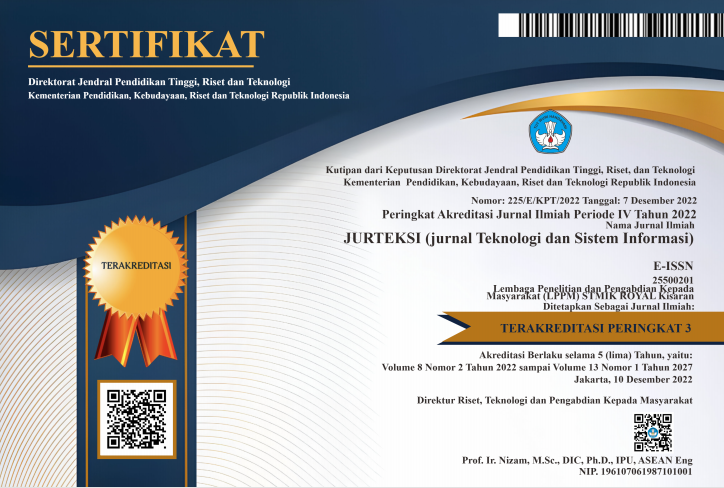UTILIZATION OF IOT TECHNOLOGY FOR TEMPERATURE MONITORING SYSTEM ON STMIK ROYAL COMPUTER LABORATORY
Abstract
Abstract : Air conditioner is an important component in a room nowadays. Due to its function as a regulator of air circulation in a room that was previously hot and stuffy, it becomes cool and comfortable. STMIK Royal Kisaran which is one of the tertiary institutions in the field of computers which has lots of air conditioners in each room, both in the theory room and in the laboratory room. Where the control and monitoring is still done manually, namely through a switch or remote control . This becomes a problem that arises when there is negligence in extinguishing it or in the ignition process. So we need a system that can turn on the air conditioner in every theoretical room or laboratory room remotely. So that the work feels lighter and more effective. In designing this control system, a NodeMCU ESP8266 module is used, which acts as the brain of the remote control system and with a DHT11 temperature sensor that can monitor room temperature. The IR Transmitter sensor acts as a connecting medium between the NodeMCU ESP8266 module and the Air Conditioner engine to regulate the temperature. So that in this way, this control system can make it easier for officers to control the Air Conditioner in the STMIK Royal campus room.
Keywords : air conditioners; dht11; internet of things; nodeMCU esp8266.
Abstrak: Air conditioner merupakan sebuah komponen penting pada suatu ruang di jaman sekarang ini. Dikarenakan fungsinya sebagai pengatur sirkulasi udara di dalam ruangan yang sebelumnya panas dan pengap menjadi sejuk dan nyaman. STMIK Royal Kisaran yang merupakan salah satu perguruan tinggi dibidang komputer yang memiliki banyak sekali air conditioner di setiap ruangannya, baik pada ruang teori serta diruang laboratorium. Di mana pada pengontrolan dan pemantauannya masih secara manual, yaitu melalui sakelar atau remot kontrol. Hal ini menjadi satu persoalan yang timbul ketika terjadi kelalaian dalam memadamkannya ataupun dalam proses penyalaannya. Sehingga dibutuhkan sebuah sistem yang dapat menyalakan air conditioner di setiap ruang teori maupun ruang laboratorium dengan jarak jauh. Sehingga pekerjaan tersebut teras lebih ringan dan efektif. Dalam perancangan sistem kendali ini digunakan sebuah modul NodeMCU ESP8266, yang berperan sebagai otak dari sistem pengendalian secara jarak jauh dan dengan sensor suhu DHT11 yang dapat memantau temperatur suhu ruangan. Sensor IR Transmitter sebagai media penghubung antara modul NodeMCU ESP8266 ke mesin Air Conditioner untuk mengatur temperatur suhu. Sehingga dengan demikian, sistem kendali ini dapat mempermudah petugas dalam mengontrol Air Conditioner di ruangan kampus STMIK Royal.
Kata kunci : air conditioner; dht11; internet of things; nodeMCU esp8266.
References
S. Siswanto, M. Anif, DN Hayati, and Y. Yuhefizar, "Securing Room Doors Using Arduino Mega 2560, MQ-2, DHT-11 Based on Android," J. RESTI (System Engineering and Technology. Information ) , vols. 3, no. 1, pp. 66–72, 2019, doi: 10.29207-/resti.v3i1.797.
AH Saptadi, "Comparative Study of Accuracy of Tempe-rature and Humidity Measu-rements Between DHT11 and DHT22 Sensors Comparative Study on ATMEL AVR and Arduino Platforms," J. Inform.
GF Pangestu and HH Purba, "Value Engineering-Based Air Conditioner Work Cost Effic-iency in Office Buildings," Syntax Lit. ; J. Ilm. Indonesia. , 2021.
Mariza Wijayanti, "Prototype Smart Home With Nodemcu Esp8266 Based on IoT," J. Ilm. Tech. , vol. 1, no. 2, pp. 101–107, 2022, doi:10.561-27/juit.v1i2.169.
A. Deris, "Emergency Infor-mation System in Mini Market Using Esp8266 Microcontro-ller Based on Internet of Things," Computing J. Ilm. Computing Science. and Matt. , vol. 16, no. 2, pp. 283–288, 2019, doi: 10.33751/kompu-tasi.v16i2.1622.
A. Najmurrokhman, "Cold Storage Using a Microcontro-ller," J. Teknol. , vol. 10, no. 1, pp. 73–82, 2018.
GS Doni Kurniawan, Yad-darabulah,"Implementation of the Internet of Things in Drip Irrigation Systems to Help Utilize Urban Farming," 7 th Univ. Res. Colloq. , pp. 106–17, 2018, [Online].
AD Pangestu, F. Ardianto, and B. Alfaresi, "Arduino Nodemcu Esp8266 Based Electrical Load Monitoring System," J. Ampere , vol. 4, no. 1, p. 187, 2019, doi: 10.31851/ampere.v4i1.2745.
I. Maulidin, A. Rohsari, I. Utami, T. Verasta, TD Guna-wan, and D. Citeureup, "Internet of Things (IoT) Training for Simple Hydropo-nic Systems in the Citeureup Community in Welcoming the Smart Nation Era Methodol-ogy Image 1 . IoT Training Dissemination in Image 3. pH Sensor Module with probe 2 . 2 IoT System Simulation,†Community, 2021,[Online].
A. Prafanto, E. Budiman, PP Widagdo, GM Putra, and R. Wardhana, "Presence Detect-ors use ESP32 for Automatic Door Lock Systems," JTT (Jurnal Teknol. Ter. , vol. 7, no. 1, p. 37, 2021, doi: 10.31884/jtt.v7i1.318.
U. Ulumuddin, M. Sudrajat, TD Rachmildha, N. Ismail, and EAZ Hamidi, "Prototype of Water Monitoring System in Internet of Things Based Tanks Using Nodemcu Esp8266 Sensors and Ultrasonics," Semin . Nas. Tech. Electrical 2017 , no. 2016, pp. 100–105, 2017, doi: 978-602-512-810-3.













